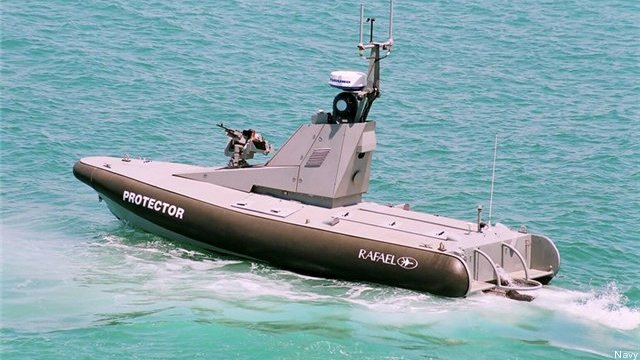Navy Puts More Bang Into Unmanned Fleet
Posted on

WASHINGTON: It looks like aerial drones are not the only unmanned systems the Pentagon is interested in arming.
The special warfare branch of the Navy’s expeditionary warfare division is eying plans to arm its small fleet of unmanned boats with an long-range missile, branch chief Capt. Evin Thompson said. The missile — known as the Spike — is built by Israeli defense firm Rafael Advanced Defense Systems, Thompson said during this week’s Association for Unmanned Vehicle Systems International-sponsored symposium in Washington. Navy officials initially tested the weapon’s performance aboard an unmanned surface vessel during the service’s latest Trident Warrior exercise. During those drills, the weapon was mounted aboard a USV originally designed as part of the anti-submarine warfare package for the Littoral Combat Ship, Thompson said. Based on those results, Navy officials decided to move ahead with additional experimentation.
The upcoming experiments will be “proof of concept” drills that will show whether or not the Spike missile can be mounted and fired from an 11-meter unmanned vessel, Navy spokeswoman Lt. Courtney Hilson said today. The drills have been tentatively set for Patuxent River Naval Air Station, but that location has not been finalized, according to Hilson. She did not go into detail on the specific capabilities the Navy is looking to get from the armed USV. But Hilson did note that any “precision engagement system” fielded by naval forces can be used for “a variety of missions ranging from force protection to offensive operations.”
If the Navy is successful in arming its fleet of autonomous ships, they will join a growing cadre of Navy drones that will carry weapons. Sea service leaders have already pegged the venerable Fire Scout as the Navy’s first aerial drone to be armed. The Marine Corps is looking at possibly arming its fleet of Shadow unmanned aerial vehicles. That growth in firepower will fill a long-standing gap in the Navy’s unmanned arsenal, Thompson said.
Weaponized drones have long been the weapon of choice for U.S counterterrorism operations. Begun under the Bush administration, the Obama White House has greatly expanded their use in recent years. That said, lethality continues to be the biggest gap in unmanned expeditionary operations, Thompson said. The intelligence, surveillance and reconnaissance abilities of the unmanned fleet remain unparalleled, he said. But “its a waste of time” to transmit the intel gathered by the drones, relay that information to a command post and have them call for artillery or airstrikes to take out the target, Thompson said. By closing that lethality gap — through the Spike-armed USVs or other options — those same drones can find, track and kill any target from a single platform, he said.
Subscribe to our newsletter
Promotions, new products and sales. Directly to your inbox.
